Valiants Memorial
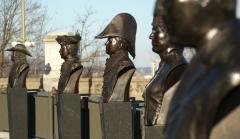
The Valiants Memorial, located in downtown Ottawa, is a collection of nine busts and five statues depicting individuals who have played a role in major conflicts throughout our history. It also includes a bronze wall inscription that reads, "No day will ever erase you from the memory of time", which is from The Aeneid by Virgil.
The monument pays tribute to the people who have served this country in times of war and the contribution they have made in building our nation. These 14 men and women were chosen for their heroism, and because they represent critical moments in Canada’s military history.
The Valiants Memorial was created by Marlene Hilton Moore and John McEwen in 2006.
The following are the fourteen Valiants and the periods they represent.
French Regime (1534-1763)
In the many wars between France and Britain during these years, the courage and tenacity displayed by inhabitants of Acadia and New France ensured the permanency of French-speaking societies in North America.
The Comte de Frontenac
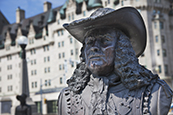
Comte de Frontenac
(1622–1698)
The most renowned of the governors of New France, he successfully defended Québec from English attack in 1690. Asked to surrender, he memorably exclaimed: “I have no reply to make other than from the mouth of my cannon.”
Pierre Le Moyne d’Iberville

Pierre le Moyne d’Iberville
(1661–1706)
Born in Montréal, Iberville was a great commander who fought the English boldly, often against great odds. In 1697, when three English vessels attacked his ship, the Pélican in Hudson Bay, he sank one, boarded another and then captured their outpost at York Fort.
American Revolution (1775-1783)
This ruthless, bloody conflict, fought along an extended frontier, divided the continent into two entities: the United States of America and British North America.
Thayendanegea (Joseph Brant)
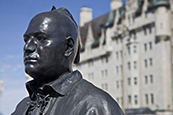
Thayendanegea (Joseph Brant)
(1742–1807)
A notable Mohawk warrior and statesman, and principal war chief of the Six Nations, he led his people in support of the British. After the war, he brought his people to Canada to settle near where Brantford now stands.
Lieutenant Colonel John Butler

Lieutenant Colonel John Butler
(1728–1796)
John Butler gathered backwoods intelligence, led Aboriginal troops, and raised a force of Loyalist refugees — Butler’s Rangers — to fight for Britain. Under his command, the Rangers fought from Kentucky to Niagara, where many settled.
War of 1812 (1812-1814)
Fought mainly to resolve Anglo-American quarrels, this war marked the successful resistance of British North America to American expansion. It was followed by lasting peace.
General Sir Isaac Brock, KCB

General Sir Isaac Brock, KCB
(1769–1812)
Commanding the forces of a deeply defeatist Upper Canada, he turned the tide of the American invasion when he captured Detroit in 1812. Although he was later killed in the battle of Queenston Heights, it was his inspiration, energy and skill that had saved Upper Canada.
Discover the story behind General Sir Isaac Brock in this Decoding ART video.
Discover the story behind General Sir Isaac Brock in this Decoding ART video.
Discover the story behind General Sir Isaac Brock in this Decoding ART video.
Lieutenant Colonel Charles-Michel d’Irumberry de Salaberry, CB

Lieutenant Colonel Charles-Michel d’Irumberry de Salaberry, CB
(1778–1829)
A skilful professional soldier, Salaberry formed the celebrated Voltigeurs canadiens. In 1813, he outwitted and defeated a vastly superior American force at the Battle of Chateauguay, helping to save Lower Canada from invasion.
Discover the story behind Lieutenant Colonel Charles-Michel d’Irumberry de Salaberry in this Decoding ART video.
Discover the story behind Lieutenant Colonel Charles-Michel d’Irumberry de Salaberry in this Decoding ART video.
Discover the story behind Lieutenant Colonel Charles-Michel d’Irumberry de Salaberry in this Decoding ART video.
Laura Secord, UE
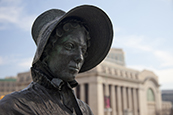
Laura Secord, UE
(1775–1868)
Thanks to Laura Secord, nearly 500 Americans surrendered at Beaver Dams in 1813, and a British defeat was averted. She had overheard plans for a surprise attack and struggled alone through miles of dense bush to warn the commander of the British outpost.
Discover the story behind Laura Secord in this Decoding ART video.
Discover the story behind Laura Secord in this Decoding ART video.
Discover the story behind Laura Secord in this Decoding ART video.
First World War (1914-1918)
Canada made huge human and economic sacrifices to support Britain and France in this terrible war. The achievements of the national army — the Canadian Corps — won Canada representation at the Paris Peace Conference and recognition on the international stage.
Matron Georgina Pope, RRC

Matron Georgina Pope, RRC
(1862–1938)
A pioneering army nurse, she was the first Canadian awarded the Royal Red Cross for conspicuous service in the field and, in 1908, became the first matron in the Canadian Army Medical Corps. She later returned to the battlefield in 1917 in France.
General Sir Arthur Currie, GCMG, KCB, VD

General Sir Arthur Currie, GCMG, KCB, VD
(1875–1933)
A courageous and innovative officer, he helped plan the great victory at Vimy Ridge. Then, as the first Canadian commander of the Canadian Corps, his brilliant leadership produced the sweeping Canadian victories of the war’s Last Hundred Days.
Corporal Joseph Kaeble VC, MM
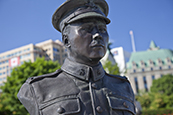
Corporal Joseph Kaeble, VC, MM
(1892–1918)
Near Arras, France, with the 22nd (French Canadian) Battalion in June 1918, the only one of his section unwounded, he leapt to the parapet with his machine gun and single-handedly repulsed some 50 attacking Germans. He was fatally wounded and posthumously awarded the Victoria Cross for his courage.
Second World War (1939-1945)
In this epic struggle against fascism, Canada mobilized its economy, and sent large land, sea and air forces into battle. With customary bravery, they contributed to victory in every theatre of war. These efforts earned Canada a strong, independent voice in the world.
Lieutenant Hampton Gray, VC, DSC

Lieutenant Hampton Gray, VC, DSC
(1917–1945)
A Canadian pilot serving with the Royal Navy’s Fleet Air Arm, and previously decorated for heroism, both in Norway and the Pacific, he earned a posthumous Victoria Cross in August 1945. Despite intense enemy fire, he attacked and sank a Japanese destroyer before his aircraft went down in flames.
Captain John Wallace Thomas, CBE

Captain John Wallace Thomas, CBE
(1888–1965)
This Newfoundlander demonstrated heroism during his service in the Merchant Navy in two world wars. In 1940, as Captain of the Empress of Scotland, he manoeuvred brilliantly under an air attack off Ireland, saving the ship and the troops on board.
Major Paul Triquet, VC
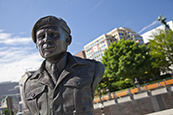
Major Paul Triquet, VC
(1910–1980)
Triquet earned the Victoria Cross in 1943 for capturing Casa Berardi in Italy, a position of great tactical importance. Surrounded, he told his men: “There is only one safe place — that is on the objective.” When he dashed forward, the men followed.
Pilot Officer Andrew Mynarski, VC

Pilot Officer Andrew Mynarski, VC
(1916–1944)
An air gunner on a burning Lancaster bomber, he made heroic but unsuccessful efforts to save his trapped comrade, the rear gunner. The latter, who finally told Mynarski to save himself and bail out, miraculously survived the crash. Mynarski died of his burns. He was posthumously awarded the Victoria Cross.